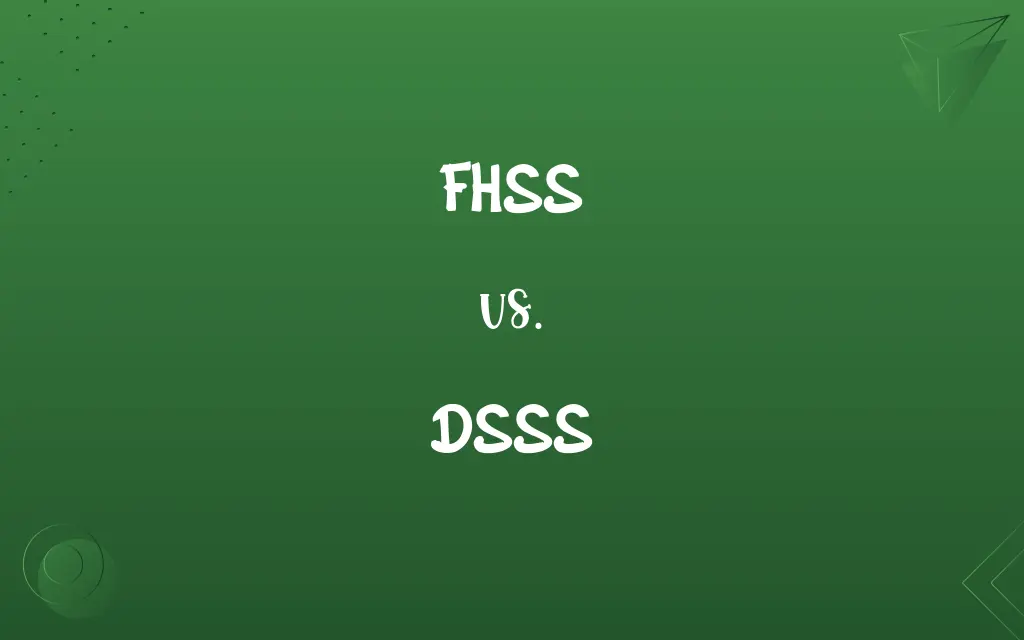FHSS vs. DSSS: Know the Difference

By Shumaila Saeed || Published on February 25, 2024
FHSS (Frequency-Hopping Spread Spectrum) uses rapid frequency changes within a band. DSSS (Direct Sequence Spread Spectrum) spreads signals over a wider frequency using a code.

Key Differences
Frequency-Hopping Spread Spectrum (FHSS) rapidly switches frequencies during transmission, creating a pattern known only to the transmitter and receiver. Direct Sequence Spread Spectrum (DSSS), on the other hand, spreads the signal across a wider frequency range using a pseudorandom code.
Shumaila Saeed
Feb 25, 2024
FHSS is commonly used in military and industrial applications due to its resistance to jamming and interference. DSSS is widely used in commercial applications, such as Wi-Fi, for its ability to maintain a stable connection even with interference.
Shumaila Saeed
Feb 25, 2024
FHSS offers enhanced security and resistance to interference by constantly changing frequencies. DSSS, while less resistant to interference, uses a unique code sequence, making it more challenging for unauthorized entities to intercept or jam the signal.
Shumaila Saeed
Feb 25, 2024
FHSS uses less bandwidth for each frequency hop but requires a broader overall bandwidth. DSSS, in contrast, utilizes a wider bandwidth for a single transmission, offering greater signal stability and range.
Shumaila Saeed
Feb 25, 2024
FHSS systems are generally more complex and expensive due to their rapid frequency-changing mechanism. DSSS systems are simpler and more cost-effective, making them a popular choice for consumer-grade wireless technologies.
Shumaila Saeed
Feb 25, 2024
ADVERTISEMENT
Comparison Chart
Frequency Usage
Uses a series of frequency hops
Spreads signal over a wider frequency
Shumaila Saeed
Feb 25, 2024
Interference
More resistant to interference
Less resistant, but uses unique codes
Shumaila Saeed
Feb 25, 2024
Bandwidth
Requires broader overall bandwidth
Uses wider bandwidth for each signal
Shumaila Saeed
Feb 25, 2024
FHSS and DSSS Definitions
FHSS
A method of transmitting radio signals by rapidly switching among many frequency channels.
In military communications, FHSS is used to avoid enemy detection and jamming.
Shumaila Saeed
Jan 16, 2024
ADVERTISEMENT
DSSS
A spread spectrum technique where a signal is spread over a wide frequency band using a code.
DSSS is used in our Wi-Fi router to improve the reliability of the wireless connection.
Shumaila Saeed
Jan 16, 2024
FHSS
A spread spectrum technique for reducing interference and improving security in wireless communications.
FHSS enhances the security of our wireless network against eavesdropping.
Shumaila Saeed
Jan 16, 2024
DSSS
A technology that multiplies a data signal with a faster code signal having a wider bandwidth.
DSSS allows multiple users to share the same frequency without significant interference.
Shumaila Saeed
Jan 16, 2024
FHSS
A method to spread a radio signal over a wide range of frequencies for transmission.
The wireless headset uses FHSS to maintain a clear connection with the base station.
Shumaila Saeed
Jan 16, 2024
DSSS
A method used in digital transmission where the data signal is combined with a higher rate bit sequence.
DSSS improves the signal-to-noise ratio in our communication network.
Shumaila Saeed
Jan 16, 2024
ADVERTISEMENT
FHSS
A technology that enables multiple access by allowing different users to use different sets of frequencies.
FHSS is efficient in managing frequency resources in crowded spectrum environments.
Shumaila Saeed
Jan 16, 2024
DSSS
A technique for transmitting signals by spreading them over a wider frequency band than necessary.
Our wireless security system utilizes DSSS to prevent signal interception.
Shumaila Saeed
Jan 16, 2024
FHSS
A technique used in wireless communication to improve the resilience of the signal against interference.
FHSS is instrumental in ensuring consistent signal quality in industrial wireless systems.
Shumaila Saeed
Jan 16, 2024
DSSS
A method in wireless communication that uses a pseudorandom sequence to spread the signal.
The use of DSSS in our communication system enhances its resistance to intentional jamming.
Shumaila Saeed
Jan 16, 2024
Repeatedly Asked Queries
What are the advantages of FHSS?
FHSS offers enhanced security and resistance to interference and jamming.
Shumaila Saeed
Feb 25, 2024
How does DSSS work?
Direct Sequence Spread Spectrum (DSSS) spreads a signal over a wider frequency band by multiplying it with a pseudorandom code.
Shumaila Saeed
Feb 25, 2024
Why is DSSS popular in Wi-Fi technology?
DSSS is preferred in Wi-Fi for its ability to maintain stable connections and resist interference using unique code sequences.
Shumaila Saeed
Feb 25, 2024
Can FHSS be used in consumer electronics?
While possible, FHSS is more common in industrial and military applications due to its complexity and cost.
Shumaila Saeed
Feb 25, 2024
Is DSSS secure against eavesdropping?
DSSS provides a level of security through its unique coding, but it's not as secure against eavesdropping as FHSS.
Shumaila Saeed
Feb 25, 2024
What is FHSS?
Frequency-Hopping Spread Spectrum (FHSS) is a method in wireless communication where the signal rapidly switches among different frequencies.
Shumaila Saeed
Feb 25, 2024
Which is more complex to implement, FHSS or DSSS?
FHSS is generally more complex to implement due to its rapid frequency-hopping mechanism.
Shumaila Saeed
Feb 25, 2024
Is DSSS suitable for high-speed data transmission?
Yes, DSSS is well-suited for high-speed data transmission, especially in consumer-grade wireless technologies like Wi-Fi.
Shumaila Saeed
Feb 25, 2024
Are FHSS transmissions easy to detect?
FHSS transmissions are not easy to detect due to the rapid changes in frequency, making them less susceptible to interception.
Shumaila Saeed
Feb 25, 2024
What applications are best suited for FHSS?
FHSS is best suited for applications requiring high security and resistance to jamming, like military and industrial settings.
Shumaila Saeed
Feb 25, 2024
Can DSSS be used in mobile communication?
Yes, DSSS is used in various forms of mobile communication, including cellular networks and wireless LANs.
Shumaila Saeed
Feb 25, 2024
What is the main difference in bandwidth usage between FHSS and DSSS?
FHSS uses a broader overall bandwidth with less for each hop, while DSSS uses a wider bandwidth for each signal.
Shumaila Saeed
Feb 25, 2024
Is DSSS affected by multipath fading?
DSSS is less affected by multipath fading compared to other technologies, due to its use of a wide frequency band.
Shumaila Saeed
Feb 25, 2024
Can FHSS and DSSS coexist in the same environment?
Yes, they can coexist, but careful planning is needed to avoid interference.
Shumaila Saeed
Feb 25, 2024
What type of interference can DSSS withstand?
DSSS can withstand narrowband interference due to its signal spreading over a wider frequency.
Shumaila Saeed
Feb 25, 2024
Does DSSS require more power than FHSS?
Generally, DSSS does not require significantly more power than FHSS, but this can vary based on the specific application.
Shumaila Saeed
Feb 25, 2024
Can FHSS be used for long-distance communication?
FHSS can be used for long-distance communication, but it's more commonly used in environments where security and interference resistance are priorities.
Shumaila Saeed
Feb 25, 2024
How does the speed of frequency hopping affect FHSS?
The speed of frequency hopping in FHSS affects both the level of security and resistance to interference.
Shumaila Saeed
Feb 25, 2024
How does FHSS improve security in communication?
FHSS improves security by constantly changing frequencies, making it difficult for unauthorized interception.
Shumaila Saeed
Feb 25, 2024
What are the cost implications of using FHSS?
Implementing FHSS typically involves higher costs due to its complexity and the technology required for rapid frequency hopping.
Shumaila Saeed
Feb 25, 2024
Share this page
Link for your blog / website
HTML
Link to share via messenger
About Author
Written by
Shumaila SaeedShumaila Saeed, an expert content creator with 6 years of experience, specializes in distilling complex topics into easily digestible comparisons, shining a light on the nuances that both inform and educate readers with clarity and accuracy.








































































